Africa Construction Market Size
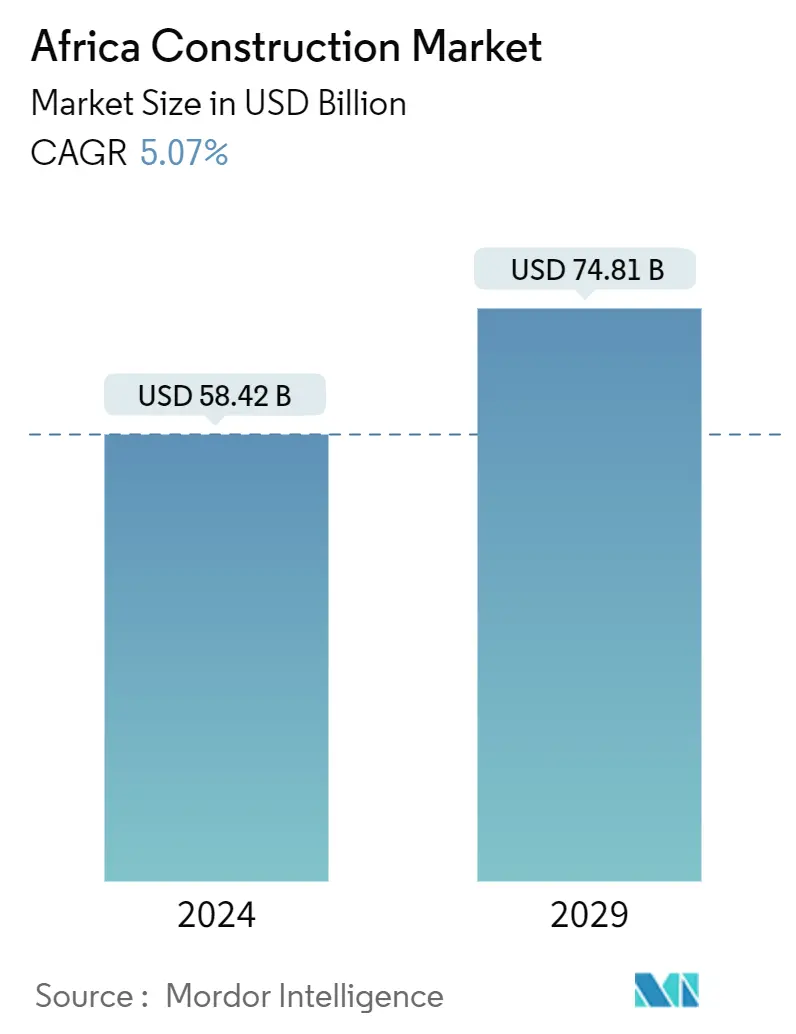
| Study Period | 2020-2029 |
| Base Year For Estimation | 2023 |
| Market Size (2024) | USD 58.42 Billion |
| Market Size (2029) | USD 74.81 Billion |
| CAGR (2024 - 2029) | 5.07 % |
| Market Concentration | Low |
Major Players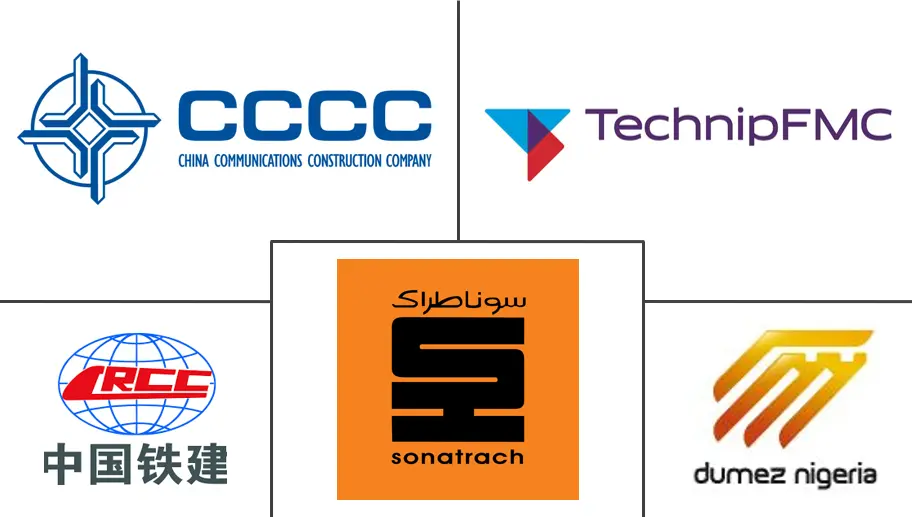
*Disclaimer: Major Players sorted in no particular order |
Africa Construction Market Analysis
The Africa Construction Market size is estimated at USD 58.42 billion in 2024, and is expected to reach USD 74.81 billion by 2029, growing at a CAGR of 5.07% during the forecast period (2024-2029).
- The COVID-19 outbreak negatively impacted the market in 2020. Over the next two years, growth was expected to remain affected due to the economic downturn caused by the pandemic across Africa's residential, commercial, industrial, and institutional sectors.
- Despite near-term challenges, the medium- to long-term outlook remains positive. Over the short term, investment in the construction industry may be driven by government spending in the infrastructure sector.
- The African construction industry is the target destination for most large economies because of accruing benefits, such as the availability of natural resources, huge investment opportunities in energy and infrastructure, cheap labor, and a fast-growing consumer market.
- The country also has a beneficial business environment that includes favorable economic development policies, rising commodity prices, continued progress in the fight against corruption, and the adoption of democratic governments.
- Business confidence is predicted to grow due to the government's assistance for small and medium enterprises (SMEs). In November 2021, the National Treasury announced its plans to spend ZAR 2.3 billion (USD142.4 million) in the current FY (April 2021 to March 2022) to help businesses affected by the third wave of the pandemic and rebuild infrastructure damaged by the civil unrest that erupted in Gauteng and KwaZulu-Natal provinces in July 2021.
- The total value of registered building plans passed by larger towns increased by 37.5% Y-o-Y in the first 10 months of 2021, following an annual fall of 33.5% in 2020, according to Stats SA. In February 2021, the government announced the investment of ZAR 791.2 billion (USD 49 billion) in public-sector infrastructure investment over the Medium-Term Expenditure Framework (MTEF) term, which runs from FY2021/2022 to FY2023/2024. The transport and logistics sector received ZAR 287 billion (USD 17.8 billion), while the energy sector received ZAR 149.9 billion (USD 9.3 billion).
Africa Construction Market Trends
Infrastructure construction projects driving the market
- African cities are changing with several major projects, ranging from magnificent skyscrapers to megacities built from scratch. These multimillion-dollar construction projects in Africa are giving its cities a much-needed transformation.
- Developing infrastructure has been a focus of many governments to meet the needs and requirements of a growing population, making construction the largest sector in Africa. There are over 570 construction projects in Africa worth USD 450 billion. The energy sector has projects worth over USD 370 billion, followed by the transportation sector, with projects that include roads, airports, and railways worth USD 280 billion.
- Egypt leads the market with over 300 active projects worth USD 338 billion. With active projects worth around USD 207 billion, South Africa comes second, followed by Nigeria, which has ongoing and upcoming projects worth USD 200 billion.
- Nigerian refineries are in a dismal state, leaving one of Africa's biggest crude oil producers to depend on petroleum imports. However, Dangote is changing that narrative with an indigenous refinery capable of processing 650,000 barrels per day, making it the largest single-train refinery in the world. The refinery spans 2,635 hectares in the Lekki Free Trade Zone, Lekki, Lagos State. It is said to cost more than USD 12 billion.
- Konza Technopolis is Kenya's smart city project, a few kilometers from Nairobi. The Kenyan government allocated 2,000 hectares of land for the project. The city is part of the government's vision for 2030 and may serve as the central hub for tech, science, telecom, and education. The estimated cost of this smart city is USD 14.5 billion, and it may generate about 20,000 jobs when completed. The first phase of the project's horizontal infrastructure works was wrapped up in 2022.
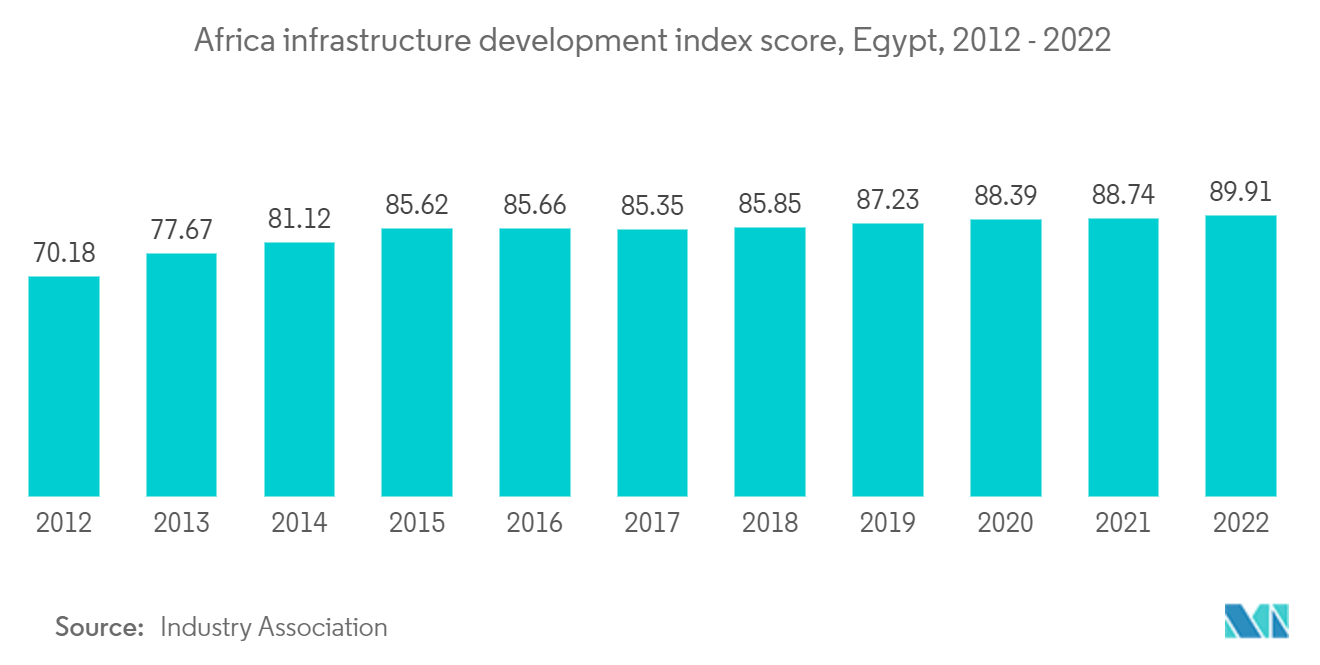
Chinese investments and BRI initiatives
- Over the last two decades, China has established a significant economic presence in most African countries. Its lucrative economic investment package, flexible political approach, and focused big-ticket development projects under the Belt and Road Initiative (BRI) provide a massive opportunity to African countries.
- China is Africa's biggest and strongest ally. In recent years, it invested millions of dollars into the continent. Chinese investment has increased globally, and Africa is the third-largest destination for China's investment, behind Asia and Europe. However, investment in Sub-Saharan Africa slightly declined in 2017, following the slight drop in aggregate Chinese investment.
- In recent years, Nigeria received relatively large funds from China for railways. China is backing two major standard-gauge rail projects, a line from Lagos to Kano and a coastal railway from Lagos to Calabar.
- The country is also building railways in Kenya, Ethiopia, and Zambia. For instance, the Chinese Export-Import Bank provided 85% of the funding for the USD 475-million Addis Ababa Light Rail, which serves the city's 4 million residents. The investments in energy, though mainly made up of oil and gas investments, comprised investments in clean energy such as hydropower.
- Despite disruptions due to the COVID-19 pandemic, Africa started construction on more than USD 160 billion worth of projects in 2021. The Export-Import Bank of China is funding projects worth more than USD 15 billion that started construction work in 2021.
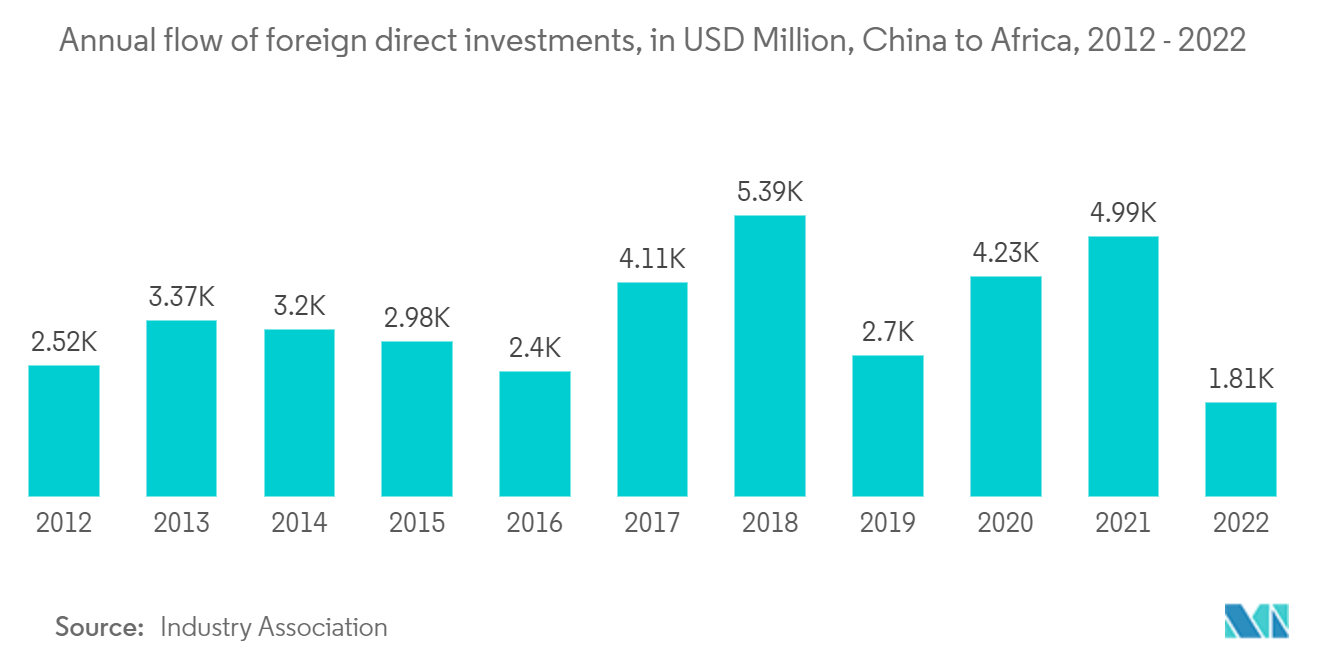
Africa Construction Industry Overview
The African construction market is less competitive, with major international players holding large market shares. The African construction market presents growth potential during the forecast period, which is expected to boost market competition. With a few players holding a significant share, the market has an observable level of consolidation. The major players are Vinci, Bouygues, TechnipFMC, China Communications Construction Group Ltd., and China Railway Construction Corp Ltd.
Africa Construction Market Leaders
-
Vinci
-
Bouygues
-
TechnipFMC
-
China Communications Construction Group Ltd.
-
China Railway Construction Coro Ltd.
*Disclaimer: Major Players sorted in no particular order
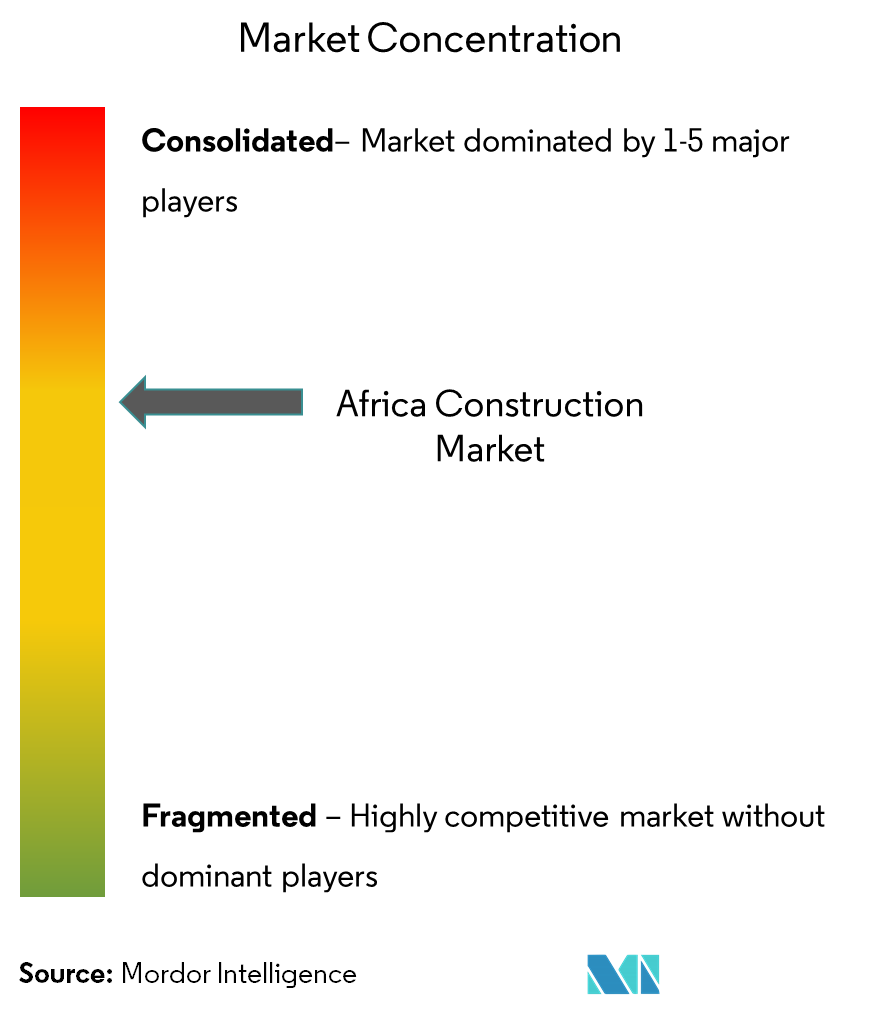
Africa Construction Market News
- December 2023: Leading renewable energy provider Scatec ASA closed the first 60 MW of the Mmadinare 120 MW Solar Complex and is on track for the start of construction of the first utility-scale solar project in Botswana.
- November 2023: Teraco, South Africa’s largest data center provider, completed an expansion of its Durban facility, bringing the total area of space to 5,800 square meters (62,430 square feet). Teraco’s Durban facility opened in 2011, providing 1MW across 600 square meters (6,460 square feet). In 2018, a previous expansion was announced, adding 1,000 square meters (10,765 square feet) of white space to the site, bringing the total space to 2,000 square meters (21,530 square feet).
Africa Construction Market Report - Table of Contents
1. INTRODUCTION
- 1.1 Study Assumptions
- 1.2 Scope of the Study
2. RESEARCH METHODOLOGY
3. EXECUTIVE SUMMARY
4. MARKET INSIGHTS AND DYNAMICS
- 4.1 Current Economic and Construction Market Scenario
- 4.2 Technological Innovations in the Construction Sector
- 4.3 Impact of Government Regulations and Initiatives on the Industry
- 4.4 Review and Commentary on the Impact of International Construction Market and Growth Potential for the Industry in the Major African Economies.
- 4.5 Review and Commentary on the Chinese Infrastructure Projects and BRI Initiative
- 4.6 Comparison of Key Industry Metrics of African Countries (Analyst View)
- 4.7 Comparison of Construction Cost Metrics of African Countries(Analyst View)
- 4.8 Impact of COVID-19 on the Market
-
4.9 Market Dynamics
- 4.9.1 Drivers
- 4.9.1.1 Rapid urbanization driving the market
- 4.9.1.2 Economic development
- 4.9.2 Restraints
- 4.9.2.1 Political and Regulatory challenges
- 4.9.2.2 Skills and Labor Shortages
- 4.9.3 Opportunities
- 4.9.3.1 Affordable housing
- 4.9.3.2 Renewable energy
-
4.10 Industry Attractiveness - Porter's Five Forces Analysis
- 4.10.1 Bargaining Power of Suppliers
- 4.10.2 Bargaining Power of Buyers/Consumers
- 4.10.3 Threat of New Entrants
- 4.10.4 Threat of Substitute Products
- 4.10.5 Intensity of Competitive Rivalry
- 4.11 Industry Value Chain Analysis
5. MARKET SEGMENTATION
-
5.1 By Sector
- 5.1.1 Commercial Construction
- 5.1.2 Residential Construction
- 5.1.3 Industrial Construction
- 5.1.4 Infrastructure (Transportation) Construction
- 5.1.5 Energy and Utilities Construction
-
5.2 By Construction Type
- 5.2.1 Additions
- 5.2.2 Demolition
- 5.2.3 New Constructions
-
5.3 By Region
- 5.3.1 Eastern Africa
- 5.3.2 Western Africa
- 5.3.3 Southern Africa
- 5.3.4 Northern Africa
6. COMPETITIVE LANDSCAPE
- 6.1 Market Concentration Overview
-
6.2 Company Profiles
- 6.2.1 China communications construction group ltd.
- 6.2.2 China railway construction corp. Ltd.
- 6.2.3 Sikhumba Construction (Pty) Ltd.
- 6.2.4 Sonatrach
- 6.2.5 Dumez Nigeria PLC
- 6.2.6 General Nile Company For Roads & Bridges
- 6.2.7 China national machinery industry corp.
- 6.2.8 TechnipFMC
- 6.2.9 Vinci
- 6.2.10 Bouygues*
- *List Not Exhaustive
7. FUTURE OF THE MARKET
8. APPENDIX
** Subject To AvailablityAfrica Construction Industry Segmentation
Construction is a very diverse industry that includes activities ranging from mining, quarrying, and forestry to constructing infrastructure and buildings, manufacturing and supplying products, and maintenance, operation, and disposal.
The African construction market is segmented by sector (commercial construction, residential construction, industrial construction, infrastructure (transportation) construction, and energy and utility construction) and by construction type (additions, demolition, and new construction, by region (Eastern Africa, Western Africa, Southern Africa, and Northern Africa).
The report offers market size and forecasts for the African construction market in value (USD) for all the above segments.
| By Sector | Commercial Construction |
| Residential Construction | |
| Industrial Construction | |
| Infrastructure (Transportation) Construction | |
| Energy and Utilities Construction | |
| By Construction Type | Additions |
| Demolition | |
| New Constructions | |
| By Region | Eastern Africa |
| Western Africa | |
| Southern Africa | |
| Northern Africa |
Africa Construction Market Research FAQs
How big is the Africa Construction Market?
The Africa Construction Market size is expected to reach USD 58.42 billion in 2024 and grow at a CAGR of 5.07% to reach USD 74.81 billion by 2029.
What is the current Africa Construction Market size?
In 2024, the Africa Construction Market size is expected to reach USD 58.42 billion.
Who are the key players in Africa Construction Market?
Vinci, Bouygues, TechnipFMC, China Communications Construction Group Ltd. and China Railway Construction Coro Ltd. are the major companies operating in the Africa Construction Market.
What years does this Africa Construction Market cover, and what was the market size in 2023?
In 2023, the Africa Construction Market size was estimated at USD 55.46 billion. The report covers the Africa Construction Market historical market size for years: 2020, 2021, 2022 and 2023. The report also forecasts the Africa Construction Market size for years: 2024, 2025, 2026, 2027, 2028 and 2029.
Construction in Africa Industry Report
Statistics for the 2024 Construction in Africa market share, size and revenue growth rate, created by Mordor Intelligence™ Industry Reports. Construction in Africa analysis includes a market forecast outlook to 2029 and historical overview. Get a sample of this industry analysis as a free report PDF download.



